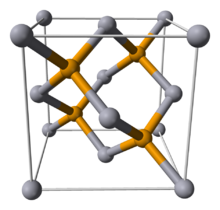Chemistry:Mercury selenide

| |
| Names | |
|---|---|
| IUPAC name
Mercury selenide
| |
| Identifiers | |
3D model (JSmol)
|
|
| EC Number |
|
PubChem CID
|
|
| |
| |
| Properties | |
| HgSe | |
| Molar mass | 279.55 g/mol |
| Appearance | grey-black solid |
| Odor | odorless |
| Density | 8.266 g/cm3 |
| Melting point | 1,000 °C; 1,830 °F; 1,270 K |
| insoluble | |
| Structure | |
| sphalerite | |
| Thermochemistry | |
Heat capacity (C)
|
178 J kg−1 K−1 |
Std enthalpy of
formation (ΔfH⦵298) |
247 kJ/mol |
| Hazards | |
| GHS pictograms |   
|
| GHS Signal word | Danger |
| H300, H310, H330, H373, H410 | |
| P260, P262, P264, P270, P271, P273, P280, P284, P301+310, P302+350, P304+340, P310, P314, P320, P321, P322, P330, P361, P363, P391, P403+233, P405, P501 | |
| NFPA 704 (fire diamond) | |
| Flash point | Non-flammable |
| Related compounds | |
Other anions
|
Mercury oxide Mercury sulfide Mercury telluride |
Other cations
|
Zinc selenide Cadmium selenide |
Except where otherwise noted, data are given for materials in their standard state (at 25 °C [77 °F], 100 kPa). | |
| Infobox references | |
Mercury selenide (HgSe; sometimes mercury(II) selenide) is a chemical compound of mercury and selenium. It is a grey-black crystalline solid semi-metal with a sphalerite structure. The lattice constant is 0.608 nm.
HgSe occurs naturally as the mineral Tiemannite, and is a component of the "intimate mixture" of HgSe and Se known as HgSe2.[1]
Along with other II-VI compounds, colloidal nanocrystals of HgSe can be formed.
Applications
- Selenium is used in filters in some steel plants to remove mercury from exhaust gases. The solid product formed is HgSe.
- HgSe can be used as an ohmic contact to wide-gap II-VI semiconductors such as zinc selenide or zinc oxide.
Toxicity
HgSe is non-toxic as long as it is not ingested due to its insolubility. Toxic hydrogen selenide fumes can be evolved on exposure to acids. HgSe is a relatively stable compound which might mean that it is less toxic than elemental mercury or many organometallic mercury compounds. Selenium's ability to complex with mercury has been proposed as a reason for the lack of mercury toxicity in deep sea fish despite high mercury levels.[2]
See also
References
- ↑ Park, Chang-Woo; Smith, Donna M.; Pell, Michael A.; Ibers, James A. (1997). "Different Products from the Chemical and Electrochemical Reduction of 'HgSe2': [K(2.2.2-cryptand)]2[HgSe2] and [PPh4]2[Hg(Se4)2]·en". Inorg. Chem. 36 (5): 942–943. doi:10.1021/ic960786v.
- ↑ Watanabe, C. (2002). "Modification of Mercury Toxicity by Selenium: Practical Importance?". The Tohoku Journal of Experimental Medicine 196 (2): 71–77. doi:10.1620/tjem.196.71. PMID 12498318.
- Nelson, D.; Broerman, J.; Paxhia, E.; Whitsett, C. (1969). "Resonant Phonon Scattering in Mercury Selenide". Physical Review Letters 22 (17): 884. doi:10.1103/PhysRevLett.22.884. Bibcode: 1969PhRvL..22..884N.
- Jayaraman, A.; Klement, W.; Kennedy, G. (1963). "Melting and Polymorphic Transitions for Some Group II-VI Compounds at High Pressures". Physical Review 130 (6): 2277. doi:10.1103/PhysRev.130.2277. Bibcode: 1963PhRv..130.2277J.
- Gawlik, K. -U.; Kipp, L.; Skibowski, M.; Orłowski, N.; Manzke, R. (1997). "HgSe: Metal or Semiconductor?". Physical Review Letters 78 (16): 3165. doi:10.1103/PhysRevLett.78.3165. Bibcode: 1997PhRvL..78.3165G. http://bib-pubdb1.desy.de/record/329689/files/document%20%282%29.pdf..
- Kumazaki, K. (1990). "Dielectric properties of narrow-gap semiconductors". Journal of Crystal Growth 101 (1–4): 687–690. doi:10.1016/0022-0248(90)91059-Y. Bibcode: 1990JCrGr.101..687K.
- SNV (1991) Guidelines on measures and methods for heavy metal emissions control. Solna, The Swedish Environmental Protection Agency – Naturvårdsverket.
External links
 |


